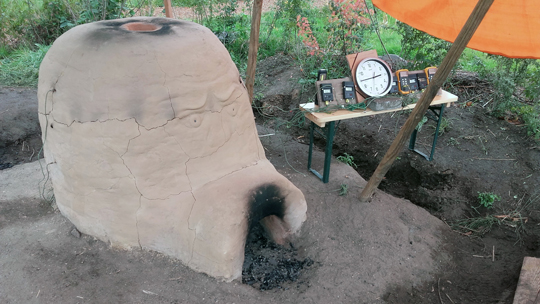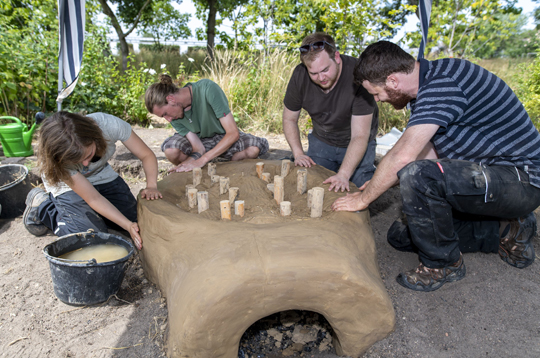Ancient Pottery
Freiburg, Oct 09, 2019
The replica of what is known as a Roman “strip-house” stands in the Black Forest town of Lahr to teach history in a lively way. A Professor of Archeology of the Roman Provinces, Alexander Heising, has with his team demonstrated that Lahr was already settled in around 230 A.D. and was a commercial center for ceramics on the southern Upper Rhine. For the state garden show in 2018, the archeologist had a replica of an ancient Roman home built in the same place. Once the house was up, interior design became an issue. Archeology students joined in to build the kind of kiln that was once located in the houses. Then, they fired it up.
 All the seminar participants used a potter’s wheel to make ceramics that were then fired in the kiln. Photo: Patrick Seeger
All the seminar participants used a potter’s wheel to make ceramics that were then fired in the kiln. Photo: Patrick Seeger
When all is said and done, Leonie Anders and Finn Hölbrock and their fellow students will have kneaded and worked two tons of loam during their seminar. The students built the kiln together with Prof. Dr. Alexander Heising of the Department for Archeology of the Roman Provinces of the University of Freiburg, an expert for experimental archeology – Frank Wiesenberg, and a team of volunteers from the working group “Gallo-Römisches Leben Lahr (Gallo-Roman Life – Lahr).” But the fact that there were no plans to refer to was a problem at the start.
Digs went on for more than eleven years at the site where Anders and Hölbrock worked for their seminar. The finds were considerable. Archeologists documented more than 9,200 artifacts of settlement structure. Among these were barrow graves, base stones of houses, wells, kilns, graves and many shards of ceramic. Heising and his team used the items to demonstrate that a Roman settlement existed in Lahr for about 150 years, starting from around 80 A.D. The archeologist from the University of Freiburg had an ancient Roman residence reconstructed on the same site for the state garden show in 2018. He says, “The building is something special, because there’s nothing else like it anywhere.”
 Firing: A wood fire that burned for a day and a night heated the kiln to a temperature of 1000 degrees Celsius. Photo: University of Freiburg
Firing: A wood fire that burned for a day and a night heated the kiln to a temperature of 1000 degrees Celsius. Photo: University of Freiburg
More than the remnants of kilns show that making pottery was the primary industry of the former residents. The fragments found have surface layers that are typical of crockery products from the Lahr settlement. The remains of these products have been found in far-flung settlements in Alsace, in Switzerland, and in the northeastern Black Forest. The archeologist says, “Wares from Lahr must’ve been popular exports.” The potters produced the full contemporary selection, discovered the Freiburg archeologist. They made cookware, mortaria, and tableware, such as plates and platters, as well as storage containers and tallow lamps.
No specialists
The early kilns were like the standard Roman ceramic kilns – round, shaft-like, so-called standing kilns, in which the firing chamber was built over the combustion chamber. They were capable of generating temperatures inside from 900 degrees to 1500 degrees Celsius. Only the lower sections of the kilns, the combustion chambers dug into the ground, remain. This showed the students that the diameter of the lower part of the kiln was about two meters. The students and teachers could only guess how the upper levels looked and were made, because no entire kiln has been found to-date in the former Roman provinces. That led Heising to turn to his colleague, experimental archeologist Frank Wiesenberg, for help. Wiesenberg says, “I get excited by finding out how something worked. If we knew, exactly what it had looked like, then building it would be easy. But I’ve got a bit of a problem with the material. I’m not quite satisfied, for example, I’m not so happy with the loam and how it’s drying. We don’t know how that went earlier.”
The seminar participants had to rely instead on loam they bought, which presumably has a different composition than what was used back then. In order to make the replicated kiln sturdy enough and ensure it would dry, they mixed in straw as well – just like the Roman period roof tiles they received as models from archeologists in Mainz. Says Wiesenberg, “As we built it, we kept learning things, because after all, these days, no one is a specialist in this area.” For the students, this was precisely a reason to take part in the seminar. “I like the range of insights that we’re getting,” says second semester archeology student Hölbrock. “And especially the practical insights, that are very different from what we learn otherwise in more theoretical seminars. This is the first experience with experimental archeology for all of us. And learning by doing is fun, “ he continues. In the end, the rebuilt kiln was slightly smaller than the original that was unearthed during the dig. The replica has a diameter of a meter and a volume of ninety to one hundred liters.
 Hands-on craftwork: The students valued the practical elements of the seminar. Photo: Patrick Seeger
Hands-on craftwork: The students valued the practical elements of the seminar. Photo: Patrick Seeger
University instruction and museum education
Beyond the hands-on part of the seminar, everything was documented in a Bachelor’s thesis. Heising explains, “We followed the experiment as researchers. For example, we noted all the hours spent working on it and how much loam we used. That was the only way we could get an idea of what happened back then. In addition to gaining practical experience, it is after all a matter of investigating the theories of experimental archeology at their interface with university instruction and museum education. “ For this reason, the museum educator Bérénice Jayme of the Lahr Town Museum and colleagues from the working group “Gallo-Römisches Leben Lahr” (Gallo-Roman Life – Lahr), also took part in the seminar.
The volunteers not only helped the students mix the loam and build the kiln on the weekends, they came to the strip-house regularly on other days, to moisten the loam so that it wouldn’t get drying cracks during the heat and in the sun. Anders, who is in her second semester of her Bachelor’s studies, enjoyed the cooperation. She says, “The volunteers really supported us a great deal. The seminar was something completely new for me. It was the hands-on aspect that was really interesting. I really wanted to learn practical approaches. It’s allowed me to get a very different perspective and understand what unfolded back then much better.”
Fired to clinky hardness
All the participants in the seminar also used a potter’s wheel to make ceramics that were then fired in the kiln. The device is not only meant to decorate the garden of the strip-house. The group wants to use it to find out how the loam they mixed behaves when the kiln is heated and how long the ceramics have to be fired. The high-point of the seminar was heating up the kiln for the first time. A wood fire that burned for a day and a night heated it to a temperature of 1000 degrees Celsius. Only a few, small, firing cracks showed up in the outer covering of the kiln. Heising explains, “We were able to fire the pieces the students made until they were hard enough to clink. Taking them out of the kiln was a real moment of suspense for the all the participants, and the success was celebrated with the party that it was due.” Several of these vessels can now be seen in a permanent exhibition at the Lahr Town Museum. What is more, further experiments are to follow. Heising says he’s sure of it: “The kiln will accompany us into the future.”
Annette Kollefrath-Persch
Article about the Roman strip-house in Lahr in the research magazine "uni'wissen" (in German)

